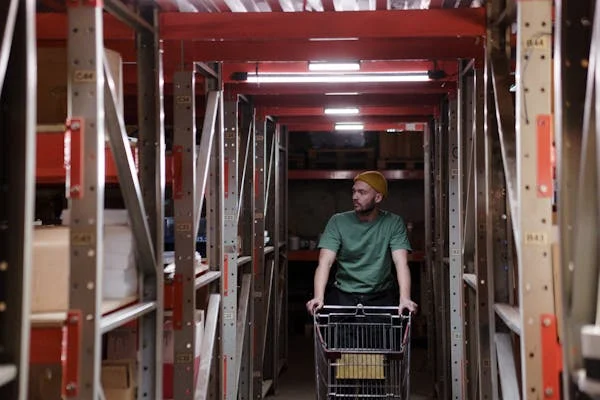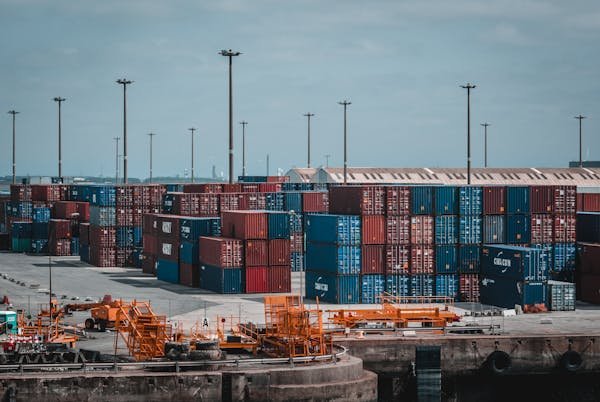Supply chains are going through a huge shift. More companies are turning to artificial intelligence (AI) to solve real problems, cut costs, and improve service. In this article, we’ll look at 30 important stats that show how AI is reshaping supply chains. Each section dives deep into one stat, explains what it means, and shares practical advice you can act on right away.
1. 61% of executives report decreased costs through AI adoption in supply chains
Understanding the impact of cost reduction
AI is not just a buzzword anymore. It’s actively saving money. Over half of the executives who’ve used AI in their supply chains have seen real cost drops. That’s huge. Think about how tight profit margins are—saving even 5–10% can mean millions for large companies.
The savings often come from automating repetitive tasks, reducing human error, and making smarter decisions faster. These improvements ripple across the entire supply chain.
Where the savings come from
AI helps companies avoid over-ordering or under-ordering inventory. It reduces shipping errors. It spots inefficiencies in routes or warehouse layout. But most of all, it gives companies better data, which leads to better decisions.
Let’s say you ship hundreds of packages a day. AI can look at delivery times, fuel usage, and routes, and suggest a better plan. Over a month, the savings are small. Over a year? You’re looking at serious numbers.
What you can do now
- Start with one area: Pick warehousing, shipping, or procurement. Don’t try to do everything at once.
- Set a clear goal: For example, reduce delivery costs by 10%.
- Find an AI tool that focuses on this goal. It could be a route optimizer or an inventory predictor.
- Track before and after: Always measure your savings to see the real benefit
2. 78% of supply chain professionals plan to implement AI in some form by 2025
Why the rush?
Nearly 8 out of 10 supply chain experts are planning to jump into AI soon. That says a lot. It means this isn’t just a trend—it’s a shift. If you’re not looking into AI, chances are your competitors are. And that puts you at a disadvantage.
This stat is a strong signal. It tells us where the industry is heading. Companies that wait too long might find themselves trying to catch up later.
What’s driving adoption
AI tools are becoming more accessible. You don’t need a team of data scientists anymore. Many platforms are plug-and-play, meaning even small businesses can use them.
Another reason? Customer expectations. People want fast shipping, real-time tracking, and fewer mistakes. AI makes this possible.
Practical advice
- Benchmark against your peers: Ask, what are others in your industry doing with AI?
- Attend webinars and demos: Learn about tools that are gaining traction.
- Build internal knowledge: Start educating your team so they’re ready for the shift.
- Don’t wait for perfection: Many businesses hesitate until a solution seems “just right.” Start small and improve as you go.
3. AI-driven forecasting can reduce errors by up to 50%
Why forecasting matters
Forecasting is the backbone of supply chains. If your predictions are off, everything else falls apart—stock levels, staffing, shipping. That’s why this stat is a game-changer.
Cutting forecasting errors by half means better inventory planning, fewer stockouts, and happier customers. It also means less waste.
How AI makes forecasting smarter
Traditional forecasting looks at past sales. AI forecasting looks at patterns, trends, seasonality, weather, and even social media mentions. It’s dynamic and real-time.
For example, if there’s a sudden spike in online buzz around a product, AI can detect it early and adjust inventory predictions before the demand surge hits.
How to use this power
- Choose AI tools that learn over time: These models get better the more data you feed them.
- Use AI to test scenarios: What happens if demand drops? Or spikes? AI can show you different outcomes.
- Link AI forecasting with inventory systems: This makes it easier to act on predictions right away.
4. AI enables a 65% reduction in lost sales due to stockouts
The stockout struggle
Stockouts hurt. Not just your revenue, but your brand too. When customers can’t find what they want, they may not come back. A 65% reduction in lost sales from stockouts is massive.
This stat shows that AI doesn’t just fix the back end—it boosts the front end too. More sales, more loyalty.
How AI prevents stockouts
AI doesn’t just tell you what’s missing. It predicts what will be missing. That’s the big difference.
With demand forecasting, real-time alerts, and supply chain visibility, you can react before stock runs out. AI systems can even reorder items automatically based on thresholds.
Action steps
- Set up demand triggers: Use AI to alert you when stock drops below a smart level—not just a fixed number.
- Group products by risk: Items that sell fast should be monitored more closely.
- Coordinate with suppliers: Let your suppliers plug into your AI tools if possible for better syncing.
5. Companies using AI see up to a 20% improvement in logistics efficiency
What is logistics efficiency?
It’s how smoothly your goods move from point A to B. Delays, wrong routes, or full trucks going half-empty all lower efficiency. A 20% boost means faster deliveries and lower costs.
AI makes logistics smart. It finds better routes, predicts traffic, and matches the right shipment with the right truck.
How AI works here
Routing algorithms consider things humans can’t—real-time traffic, road closures, weather, fuel prices. AI updates plans on the fly.
It also helps with load planning. Are your trucks full? Are you wasting space? AI can fix that.
What to do now
- Use dynamic routing tools: These help drivers avoid delays in real time.
- Optimize last-mile delivery: AI can cut down wait times and improve success rates.
- Measure key metrics: Delivery time, cost per delivery, and fuel usage should improve with AI.
6. 63% of retailers say AI enhances their supply chain visibility
The problem with blind spots
When you can’t see what’s happening in your supply chain, you can’t fix what’s broken. AI gives you eyes—across borders, warehouses, and trucks.
With 63% of retailers already feeling this benefit, it’s clear AI is making a difference.
What visibility really means
It means knowing where every item is. Not just shipped—but in transit, at customs, stuck in a delay. Visibility also means understanding why delays happen.
AI brings all your data together. It removes silos. You don’t have to log into five different systems anymore.
Steps you can take
- Unify your data: Use AI tools that pull info from every part of your supply chain.
- Set alerts for exceptions: You don’t need to watch everything, just the stuff that goes wrong.
- Build dashboards: Use AI-powered dashboards to view real-time movement of goods.
7. AI-enabled supply chains experience up to 30% faster decision-making
Why speed matters in supply chains
Supply chains live and die on timing. Whether it’s fulfilling orders, reacting to shortages, or choosing the best shipping partner, delays cost money. Faster decisions keep everything moving.
AI helps make decisions quickly by processing large amounts of data and recommending the best action—without waiting for long analysis meetings or manual reports.
Where AI accelerates decision-making
Let’s say a shipment is delayed. Instead of waiting for someone to notice, escalate, and find an alternative, AI will flag it instantly and suggest rerouting options. It even ranks them by cost, speed, and reliability.
AI also helps with real-time pricing decisions, supplier shifts, and inventory allocation. All of these once took hours or days. Now, they take minutes—sometimes seconds.
How to make your decisions faster with AI
- Automate exception handling: Set up rules for AI to act on routine problems automatically.
- Use AI dashboards: Instead of static reports, use dashboards that update in real time with decision recommendations.
- Give teams AI playbooks: Help teams know when to trust AI decisions and when to intervene manually
8. Machine learning helps reduce supplier risk by up to 40%
The hidden risks of supplier relationships
Suppliers are key partners, but they also bring risk—missed deliveries, quality issues, or financial instability. Machine learning helps identify which suppliers might cause problems before it’s too late.
By analyzing historical data, financial reports, social media signals, and even weather trends, AI can tell you who might be in trouble or underperforming soon.
Real-world examples
Let’s say a supplier in another country starts showing delays or financial strain. AI can detect patterns across invoices, delivery timelines, and external news. It alerts you and recommends alternatives—fast.
This lets you plan ahead, switch suppliers early, or renegotiate terms before issues explode.
How to start reducing supplier risk
- Feed AI your supplier data: Include invoices, contracts, and performance metrics.
- Use external signals: Let your AI tool read market news, credit reports, and logistics data.
- Build a supplier scorecard: AI can update scores in real-time, showing who’s becoming risky.
9. 54% of companies invest in AI to optimize transportation routes
Getting from A to B isn’t simple anymore
Traffic, fuel prices, customer windows, weather—transportation planning has so many variables. AI takes the guesswork out by calculating the smartest path based on all current data.
Over half of companies are already investing in AI to improve routing. That’s because small savings per route add up fast.
How it works
AI uses live traffic data, delivery urgency, truck capacity, driver hours, and other factors to find the most efficient route. It also learns over time—if a shortcut causes delays, AI avoids it in the future.
This doesn’t just save money. It reduces carbon emissions, improves on-time delivery, and makes better use of your fleet.
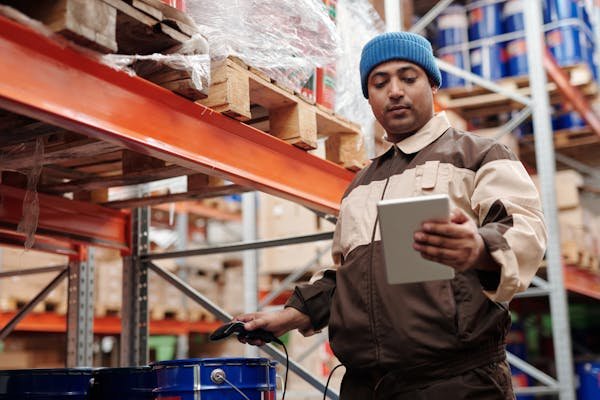
Tips to optimize your routing with AI
- Use route simulation tools: Test different routes before sending trucks out.
- Track KPIs: Compare mileage, fuel cost, and delivery times before and after AI use.
- Combine with real-time tracking: AI makes better decisions when it knows where your trucks are now—not just where they were scheduled to be.
10. AI can reduce warehouse operating costs by up to 25%
The cost of running a warehouse
Labor, utilities, storage, equipment—warehouses are expensive. AI brings down these costs by making every process leaner and faster. A 25% cut is not just helpful—it’s game-changing.
From picking routes to space planning, AI eliminates waste. It tells you how to store smarter, staff more efficiently, and reduce energy use.
Where AI works best in warehouses
AI-powered robots can move goods faster. Computer vision can spot damaged items. Predictive tools can staff shifts based on expected volume. And AI can help redesign warehouse layouts for faster flows.
These aren’t futuristic ideas—they’re happening now.
How to get started
- Digitize your warehouse: Make sure systems are connected and trackable.
- Install sensors and cameras: AI uses them to learn traffic patterns and workflow issues.
- Train staff to work with AI tools: Human-AI collaboration leads to bigger savings than full automation alone.
11. 70% of companies use AI to monitor real-time inventory
Why real-time matters
Old inventory systems used to update once a day—or even once a week. That doesn’t cut it anymore. If your numbers are off by even a little, it creates chaos downstream.
Today, 7 out of 10 companies are using AI to track inventory in real time. That means they know what’s available, where it is, and how fast it’s moving—every second.
How AI improves inventory tracking
AI uses barcodes, RFID, IoT sensors, and machine learning to keep track of stock. It also predicts when items will run low based on current trends, not just static reorder points.
This lets companies respond instantly to changes in demand or supplier delays.
What you can do
- Install smart sensors or RFID: These feed real-time data into your AI system.
- Set dynamic reorder levels: Let AI adjust them based on sales trends or seasonality.
- Integrate with forecasting tools: So your AI inventory system also knows what’s coming, not just what’s here.
12. Predictive maintenance via AI reduces equipment downtime by 40%
Equipment downtime is expensive
Every minute your equipment is down costs money. Whether it’s a forklift, conveyor belt, or packaging machine, delays stack up fast. Predictive maintenance helps you avoid surprises.
AI looks at equipment data—vibrations, temperature, usage—and spots patterns that show something is about to break.
How predictive maintenance works
Instead of scheduling checks every 6 months, AI tells you exactly when a part needs attention. It finds issues before they cause breakdowns.
This doesn’t just prevent downtime—it also extends equipment life and reduces emergency repair costs.
Steps to apply it
- Use sensors that track machine health: Vibration, temperature, oil levels, etc.
- Connect these to an AI platform: It will start learning what normal looks like—and flag issues.
- Act on early alerts: Don’t wait until something fails. That’s the whole point.
13. 85% of supply chain leaders say AI will be a competitive advantage
Why AI is becoming the new edge
AI is no longer optional. It’s becoming a key differentiator. Most supply chain leaders now believe that using AI gives them a leg up over the competition. That means if you’re not using it, you’re falling behind.
The reason is simple: AI makes your supply chain smarter, faster, and more agile. In a world where customers expect instant service and global disruptions happen regularly, agility is everything.
What makes it a competitive advantage
When your competitors are guessing, you’re predicting. When they react to problems, you prevent them. AI helps you make better decisions in less time, with fewer resources.
Think about predictive analytics, dynamic routing, smart inventory management—all areas where AI delivers real value. The result? Faster delivery, lower costs, fewer errors, and happier customers.
How to gain an edge with AI
- Start small but move fast: Don’t wait for a perfect solution. Implement AI in one function and learn quickly.
- Tie AI to your goals: Whether it’s faster delivery or fewer returns, align AI with your strategy.
- Stay curious: AI is evolving fast. Keep learning, testing, and adapting as new tools emerge.
14. AI increases demand forecast accuracy by up to 35%
Better forecasts mean better supply chains
Forecasting is hard. One wrong assumption, and you’ve either overstocked or understocked. AI fixes that by looking at way more data than humans ever could—weather, promotions, news events, competitor moves, and more.
A 35% improvement in forecast accuracy can completely change your bottom line. Less waste, fewer lost sales, and better customer service.
What AI uses to forecast better
AI doesn’t rely on just sales history. It also tracks real-time trends—what’s trending on social media, how weather is changing demand, and what similar products are doing.
It constantly learns and adjusts, so your forecasts are always improving.
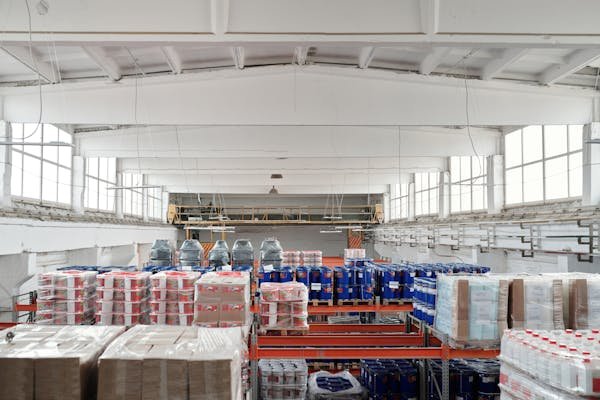
Ways to improve your forecasting
- Feed AI broad data: Go beyond sales. Include marketing campaigns, shipping times, and even local events.
- Update models regularly: Don’t use the same settings forever. Let AI evolve with your business.
- Collaborate across teams: Sales, marketing, and supply chain should all contribute data to your AI tool.
15. 45% of manufacturers use AI for quality inspections and defect detection
Quality problems are costly
Every time a defective product leaves your factory, you risk returns, refunds, and customer complaints. Manual inspections are slow and inconsistent. AI changes that.
Almost half of manufacturers are now using AI to catch defects early. This improves quality and lowers waste—without slowing down production.
How AI does better inspections
Computer vision tools powered by AI can scan products faster than any human. They catch tiny imperfections the eye might miss, and they do it all day long without losing focus.
Machine learning also helps AI get better over time. It learns what a defect looks like, even when that changes.
Steps to improve quality with AI
- Use high-resolution cameras on production lines: These feed images into your AI model.
- Train your AI with real examples: Show it what defects look like so it learns faster.
- Automate alerts: When AI finds a problem, it should immediately trigger a halt or quality check.
16. AI reduces procurement cycle times by up to 35%
Why procurement needs speed
Procurement is more than just buying stuff. It’s about getting the right goods at the right time and price. Slow procurement leads to delays in production and fulfillment. AI helps streamline the entire process.
With up to a 35% reduction in cycle times, you can react faster to changes in demand or supplier availability.
How AI accelerates procurement
AI tools automate supplier selection, contract analysis, and even negotiations. They recommend suppliers based on performance, price, and risk. They also help predict future needs so you’re not buying at the last minute.
Some AI platforms even manage communications and approvals, making the process smoother across departments.
What you can do
- Use AI to rank suppliers: Based on lead time, price stability, and quality.
- Let AI handle routine buys: Reorders and repeat contracts can be automated.
- Link procurement to demand planning: Let your AI forecast tell your procurement team what’s needed and when.
17. Natural Language Processing (NLP) enhances supplier communication for 40% of firms
Communication is everything
Miscommunication causes delays, errors, and missed expectations. Natural Language Processing (NLP) solves this by analyzing emails, documents, and chats for clarity and intent.
40% of firms are already using NLP to make supplier communication clearer, faster, and more efficient.
How NLP works
NLP tools can read supplier emails and flag urgent issues, missing documents, or unclear terms. They can even translate messages, summarize long threads, and suggest next steps.
This reduces back-and-forth and keeps everything moving.
How to use NLP in your supply chain
- Install AI inbox assistants: These highlight priority messages and summarize conversations.
- Train your AI on contract language: NLP can flag unusual terms or compliance risks.
- Use NLP to create standardized replies: Let your team respond faster with smart templates.
18. 50% of logistics providers use AI for delivery time estimation
Why accurate delivery time matters
Customers expect you to deliver on time—and tell them exactly when that will be. Missed estimates frustrate customers and lead to churn.
Half of logistics providers are now using AI to give accurate, real-time delivery estimates. That’s how you build trust.
What makes AI better at estimating delivery
AI tracks live traffic, weather, driver behavior, and historical trends. It updates delivery windows as conditions change. Unlike static estimates, AI adjusts on the fly.
This doesn’t just improve customer satisfaction—it helps reduce failed deliveries and rescheduling costs.
How to improve your delivery promises
- Use AI tools that pull from GPS and traffic APIs: These offer minute-by-minute updates.
- Show dynamic ETAs to customers: On websites, emails, or mobile apps.
- Track on-time delivery rates: And let AI recommend ways to improve them.
19. AI improves order fulfillment rates by up to 30%
Order fulfillment is the heartbeat of customer satisfaction
Customers don’t just care about fast shipping—they care about correct shipping. Getting the right product, in the right quantity, at the right time is the core of order fulfillment. AI improves this by helping you avoid delays, pick errors, and stock mismatches.
A 30% improvement means fewer cancelled orders, lower return rates, and happier customers. That’s not a small win—it’s a game-changer.
What AI changes in fulfillment
AI-powered systems optimize picking paths in warehouses, reduce packing errors, and coordinate with shipping partners more efficiently. It also anticipates demand and routes orders to the right fulfillment centers, even before a purchase is complete.
It’s like having a 24/7 operations expert working in the background, constantly making sure your fulfillment machine runs smoothly.

Actions you can take
- Link AI with your order management system: Let it suggest fulfillment centers based on proximity and availability.
- Use AI to predict returns: Some tools can tell which orders are likely to be returned and flag them early.
- Automate warehouse priorities: Let AI set picking orders to meet delivery promises more efficiently
20. Chatbots resolve supply chain queries 80% faster
The bottleneck of slow communication
Whether it’s a vendor asking about payment status or a customer wondering where their package is, slow replies hurt business. That’s where AI chatbots come in. They work 24/7, never get tired, and resolve issues fast.
An 80% speed improvement isn’t just about efficiency—it’s about reducing stress, building trust, and freeing up your human team for more complex tasks.
How AI chatbots are used in supply chains
Chatbots handle common supplier queries, delivery updates, invoice tracking, and even document retrieval. Some advanced ones escalate issues when needed and offer real-time updates from multiple systems.
They also ensure consistency. No more mixed messages depending on who replies.
How to use them effectively
- Start with high-volume queries: Track the top 10 questions your team answers daily. Automate those first.
- Train your chatbot regularly: Feed it updated process flows and company policies.
- Keep a human in the loop: Make sure complex queries escalate quickly to the right person.
21. AI in cold-chain logistics reduces spoilage by 20%
Spoilage is expensive and wasteful
Cold-chain logistics—used in food, pharma, and chemicals—is highly sensitive. A small temperature shift can mean thousands in spoiled goods. AI helps prevent that.
A 20% reduction in spoilage saves money, reduces waste, and ensures safety, especially in sectors like healthcare where integrity is non-negotiable.
What AI monitors in cold chains
AI uses temperature sensors, humidity trackers, and location data to detect risks. It predicts failures before they happen and reroutes shipments if a freezer truck breaks down.
It can also tell you which routes, warehouses, or partners are most likely to cause spoilage.
Steps to implement
- Install smart sensors across the chain: These feed data to your AI system for analysis.
- Set predictive alerts: AI should notify you before spoilage happens—not after.
- Optimize carrier selection: Use AI data to rank logistics partners based on spoilage risk.
22. 60% of supply chain disruptions are mitigated faster with AI alerts
Disruptions happen—how fast you react matters
Disruptions can come from weather, strikes, port delays, or raw material shortages. While you can’t prevent them all, you can respond faster. AI enables this with early detection and real-time alerts.
Faster mitigation helps you avoid missed deadlines, angry customers, and costly rerouting.
How AI keeps you ahead of problems
AI scans global news, supplier networks, and logistics feeds to detect issues. It then alerts the right teams with actionable recommendations—reroute a shipment, increase safety stock, or notify customers.
It also learns over time. The more disruptions it sees, the better it gets at predicting and preventing them.
What you can do now
- Connect AI to multiple data sources: Social media, weather, traffic, and supplier updates.
- Define thresholds for action: Don’t drown in alerts. Only get notified when action is needed.
- Automate your playbook: Build pre-approved mitigation steps that AI can trigger with minimal human input.
23. Companies using AI see 15% improvement in customer satisfaction
Happy customers come from smooth operations
When your supply chain runs well, customers feel it—even if they never see it. On-time deliveries, accurate orders, and good communication all contribute to a better experience. AI helps drive each of those.
A 15% bump in satisfaction can translate to better reviews, repeat purchases, and higher lifetime value.
Where AI makes customers happy
AI improves communication (chatbots, delivery updates), predicts customer needs (personalized fulfillment), and ensures fewer mistakes. It also helps you offer accurate ETAs and proactive issue resolution.
Customers may not know you’re using AI—but they’ll feel the difference.

Tactics for better CX with AI
- Use AI to personalize communication: Let it tailor order updates and product suggestions.
- Track satisfaction scores: Use AI to analyze reviews and feedback trends.
- Flag risky experiences: If AI detects a likely delay, notify customers early with a discount or update.
24. 47% of businesses deploy AI for dynamic pricing and demand shifts
Pricing is no longer static
In a fast-moving market, fixed pricing doesn’t cut it. Demand can spike overnight, costs can change quickly, and customer willingness to pay varies by channel. That’s why nearly half of companies now use AI for dynamic pricing.
AI helps adjust prices in real-time based on supply, demand, and competition—keeping you profitable and competitive.
How AI handles pricing
AI tracks real-time inventory, sales velocity, competitor prices, and customer behavior. It finds the perfect price point to maximize margin while staying competitive.
It can also test pricing strategies across different geographies, times of day, or customer segments.
How to apply dynamic pricing
- Choose a flexible AI pricing engine: One that lets you set guardrails and monitor results.
- Start with high-volume SKUs: These are most impacted by price sensitivity.
- Run A/B tests: Compare AI-driven pricing to manual methods and refine accordingly.
25. 67% of AI adopters in supply chain use robotic process automation (RPA)
Automation is no longer just for robots
Robotic Process Automation (RPA) doesn’t involve physical robots—it’s about software that handles repetitive, rules-based tasks. In supply chains, RPA helps manage invoices, update records, process orders, and more.
Two-thirds of companies using AI also use RPA. That’s because when AI predicts or recommends something, RPA takes action automatically.
Why RPA and AI work so well together
Imagine AI tells you a supplier has missed three deliveries and is now high-risk. Instead of a human updating the system, RPA can flag the supplier, notify procurement, and even pause further orders—within seconds.
This seamless handoff reduces delays, improves accuracy, and frees up employees to focus on strategic work.
How to implement RPA in your supply chain
- Start with repetitive admin tasks: Invoicing, PO approvals, and inventory logging are great starting points.
- Pair RPA with AI triggers: Let AI detect events and RPA act on them.
- Track process timing: Use metrics to measure how much faster your tasks become with RPA.
26. AI reduces time spent on routine tasks by 70%
Time is money—and AI gives you both
Routine tasks eat up valuable hours. Think about tracking orders, compiling reports, or scanning contracts. AI handles these tasks faster, with fewer errors, and without taking coffee breaks.
Cutting 70% of time spent on these tasks means your team can focus on growth, strategy, and problem-solving.
Where AI saves the most time
Report generation, status updates, document review, and workflow management are top areas where AI excels. Tools can pull data, format reports, and send updates automatically.
In logistics, AI can also auto-fill delivery logs and status updates, freeing up driver and admin time.
What to do now
- Audit time-wasting tasks: Identify 5-10 activities your team repeats every day.
- Find AI tools designed for those tasks: Look for ones that plug into your existing systems.
- Set realistic goals: Start by automating 20–30% of tasks, then scale up as you gain confidence.
27. Companies using AI-powered sourcing tools report 18% cost savings
Sourcing isn’t just about finding a supplier—it’s about finding the right one
When AI enters the sourcing process, it brings data, context, and analysis. It doesn’t just match you with suppliers; it evaluates them across quality, price, reliability, and risk. That’s why companies are saving up to 18% on sourcing costs.
Those savings come from better decisions—not just cheaper deals.
How AI improves sourcing
AI analyzes spend data, historical performance, and even supplier behavior over time. It also predicts future pricing trends and contract risks, helping you negotiate smarter.
Some AI tools even suggest alternative suppliers when it senses risk, shortages, or delays.
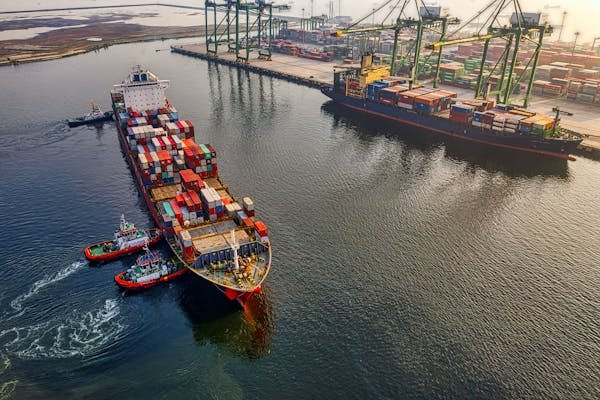
Actions to take
- Feed AI your full sourcing history: The more data, the better the recommendations.
- Use AI to identify supplier overlap: Consolidate purchases for volume discounts.
- Track sourcing KPIs: AI should help reduce lead time, improve quality, and lower risk—measure all three.
28. 52% of warehouses use AI to manage labor productivity
People are still at the heart of the supply chain—but AI makes them more effective
Managing labor in a warehouse is tough. Peaks and valleys in demand, shift changes, and inconsistent workloads create chaos. AI brings clarity.
Over half of warehouses now use AI to match staffing levels to demand, assign tasks efficiently, and reduce idle time.
What AI looks at
AI analyzes traffic patterns, picking speeds, shift performance, and warehouse layout. It helps assign the right people to the right jobs and flags issues like underperformance or overstaffing.
It also forecasts when labor needs will spike—helping you hire or reschedule before it becomes a crisis.
How to use AI for labor management
- Use real-time dashboards: Track worker productivity and workload balance live.
- Set dynamic staffing levels: Let AI recommend staffing changes based on order volume or delivery schedules.
- Train team leaders: Equip them with AI insights to improve shift planning and productivity coaching.
29. AI enhances supply chain resilience in 64% of organizations
Resilience is more important than ever
From global pandemics to wars and natural disasters, supply chains are under constant pressure. AI helps companies bounce back faster—or avoid problems altogether.
Nearly two-thirds of organizations say AI has improved their resilience. That means less disruption, faster recovery, and smarter planning.
What makes a resilient supply chain
A resilient supply chain anticipates risk, responds fast, and adapts quickly. AI enables all three by providing early warnings, modeling scenarios, and automating recovery steps.
It helps you build contingency plans not when disaster strikes—but before.
How to build resilience with AI
- Run simulations: Use AI to test how your supply chain holds up under stress—like port closures or supplier failures.
- Map your network risk: Let AI highlight where your vulnerabilities are.
- Create response workflows: Use AI to suggest and even trigger responses automatically when thresholds are hit.
30. Firms using AI-driven supply chain platforms report a 2x ROI within the first year
The ultimate question: is AI worth it?
The answer is a clear yes. Companies that implement AI platforms in their supply chain often see double their investment back—within just one year.
That’s not over five years or even three. One year.
This ROI comes from savings, efficiency, better decisions, and improved customer retention. Once you’ve paid for the tools, the gains continue.
What drives this fast ROI
Lower costs, fewer errors, faster fulfillment, smarter sourcing, and better demand planning all stack up. AI turns everyday decisions into compounding wins.
The faster you implement and integrate, the sooner you’ll see these benefits.

How to ensure ROI on AI
- Pick platforms with proven case studies: Don’t go experimental unless you’re ready to learn fast.
- Integrate with existing systems: The faster the connection, the faster the returns.
- Track ROI monthly: Set KPIs before launch so you can measure progress as you go.
Conclusion
AI is not the future of supply chains—it’s the now. Across forecasting, logistics, procurement, warehousing, and customer experience, AI is quietly transforming how companies operate. The best part? It’s not reserved for billion-dollar corporations anymore.




